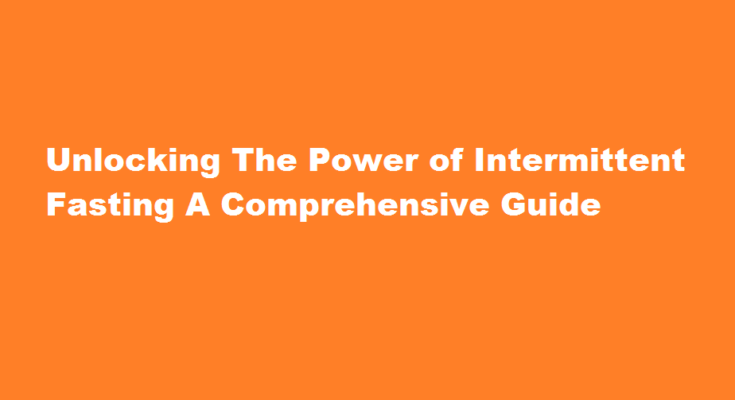Introduction
In recent years, intermittent fasting has gained significant popularity as a promising dietary approach for weight loss, improved metabolic health, and longevity. By cycling between periods of fasting and eating, this eating pattern harnesses the body’s natural rhythms to optimize various physiological processes. In this article, we will delve into the details of intermittent fasting and explore different methods to incorporate it into your lifestyle for optimal results.
Understanding Intermittent Fasting
Intermittent fasting is not a diet in the conventional sense; rather, it is an eating pattern that alternates between fasting and eating windows. It encompasses several different protocols, such as the 16/8 method, where you fast for 16 hours and eat within an 8-hour window, and the 5:2 diet, which involves eating normally for five days and restricting calorie intake on the remaining two days.
Benefits of Intermittent Fasting
Numerous studies have highlighted the potential benefits of intermittent fasting beyond weight loss. It can enhance insulin sensitivity, reduce inflammation, support cellular repair processes, and promote brain health. Additionally, intermittent fasting has been associated with increased autophagy, a cellular process that removes damaged molecules, leading to potential anti-aging effects.
Getting Started with Intermittent Fasting
Before embarking on an intermittent fasting journey, it’s essential to consult with a healthcare professional, particularly if you have any underlying health conditions. Once you receive the green light, begin by selecting a suitable fasting method based on your lifestyle and preferences. Remember, adherence and consistency are key to achieving desired results.
Tips for Successful Intermittent Fasting
- Start slowly If you’re new to fasting, consider gradually increasing your fasting duration over time. Begin with shorter fasting windows and gradually extend them as your body adapts.
- Stay hydrated During fasting periods, it’s vital to stay hydrated by drinking water, herbal tea, or black coffee, which can help reduce hunger pangs.
- Focus on nutrient-dense foods Opt for whole, unprocessed foods during your eating window to ensure you’re getting essential nutrients while promoting satiety.
- Listen to your body Pay attention to your hunger and fullness cues. If you feel excessively hungry or unwell during fasting, it may be necessary to adjust your fasting schedule or seek guidance.
- Be flexible Intermittent fasting is meant to be adaptable to your lifestyle. It’s okay to modify your fasting schedule to accommodate social events or specific circumstances occasionally.
Potential Challenges and Solutions
Intermittent fasting may pose challenges initially, such as hunger, cravings, or difficulty adjusting to new eating patterns. To overcome these hurdles, ensure you’re consuming balanced meals during your eating window, including sufficient protein, healthy fats, and fiber. Distracting yourself with engaging activities or adjusting your fasting and eating windows can also help manage these challenges.
Frequently Asked Questions
What is the most successful method of intermittent fasting?
16/8 fasting is the most popular intermittent fasting method. It is a bit more advanced than the first two versions, but still very beginner-friendly. You eat within an eight-hour period every day and fast for 16 hours. Most people eat two meals during this period: Either breakfast and lunch or lunch and dinner.
Which intermittent fasting burns the most fat?
Occasional fasting combined with regular weight training is best for fat loss, Pilon says. By going on one or two 24-hour fasts during the week, you allow yourself to eat a slightly higher number of calories on the other five or six non fasting days.
Conclusion
Intermittent fasting is a flexible and promising approach to improve health and well-being. By adhering to the principles of intermittent fasting, adopting a gradual approach, and personalizing the method to suit your lifestyle, you can harness the benefits of this eating pattern. Always remember to listen to your body and consult a healthcare professional if needed, and embark on your intermittent fasting journey with confidence.
Read Also : Becoming an Expert at Mental Calculations with Your Fingers



